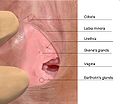
Pelvic examination
Encyclopedia

Physical examination
Physical examination or clinical examination is the process by which a doctor investigates the body of a patient for signs of disease. It generally follows the taking of the medical history — an account of the symptoms as experienced by the patient...
of the female
Female
Female is the sex of an organism, or a part of an organism, which produces non-mobile ova .- Defining characteristics :The ova are defined as the larger gametes in a heterogamous reproduction system, while the smaller, usually motile gamete, the spermatozoon, is produced by the male...
pelvic organ
Organ (anatomy)
In biology, an organ is a collection of tissues joined in structural unit to serve a common function. Usually there is a main tissue and sporadic tissues . The main tissue is the one that is unique for the specific organ. For example, main tissue in the heart is the myocardium, while sporadic are...
s.
Broadly, it can be divided into the external examination and internal examination.
It is also called "Bimanual Exam" & "Manual Uterine Palpation".
Internal examination
Use of speculumSpeculum (medical)
A speculum is a medical tool for investigating body cavities, with a form dependent on the body cavity for which it is designed. In old texts, the speculum may also be referred to as a diopter or dioptra...
to locate external cervical os.
Examination for foreign bodies.
Manoeuvres
- test for cervical motion tendernessCervical motion tendernessIn gynecology, cervical motion tenderness or cervical excitation , is a sign found on pelvic examination suggestive of pelvic pathology. Classically, it is present in the setting of pelvic inflammatory disease , ectopic pregnancy and is of some use to help differentiate PID and appendicitis...
, as classically seen in pelvic inflammatory diseasePelvic inflammatory diseasePelvic inflammatory disease is a generic term for inflammation of the uterus, fallopian tubes, and/or ovaries as it progresses to scar formation with adhesions to nearby tissues and organs. This may lead to infections. PID is a vague term and can refer to viral, fungal, parasitic, though most... - palpationPalpationPalpation is used as part of a physical examination in which an object is felt to determine its size, shape, firmness, or location...
of adnexaAdnexaIn anatomy, adnexa refers to the appendages of an organ. The term adnexa stems from a Latin word meaning appendages.More specifically, it can refer to:* Adnexa of eye * Adnexa of uterus...
l structures - cervical swabs
- vaginal swabs
- Pap smearPap smearThe Papanicolaou test is a screening test used in to detect pre-cancerous and cancerous processes in the endocervical canal of the female reproductive system. Changes can be treated, thus preventing cervical cancer...
Discomfort
The exam should not be excessively uncomfortable, but a woman with a vaginal infection may feel pain when the speculum is inserted. During the bimanual exam, the palpating of the ovaries may be painful. The pap test may cause some cramping as well.Informed consent
For educational purposes, trainee doctors have performed pelvic exams on unconscious women. The subjects are those undergoing surgery for unrelated causes, and they were rarely informed the examination had occurred. This practice was forbidden in the United States and the United Kingdom, which now require the patient to consent in advance. The practice still continues in Canada according to a study published in the Journal of Obstetrics and Gynecology. The director of the Medical Health program at the University of ManitobaUniversity of Manitoba
The University of Manitoba , in Winnipeg, Manitoba, Canada, is the largest university in the province of Manitoba. It is Manitoba's most comprehensive and only research-intensive post-secondary educational institution. It was founded in 1877, making it Western Canada’s first university. It placed...
claimed in response that the revised 2006 guidelines of the Society of Obstetricians and Gynecologists of Canada forbade pelvic exams without consent, though the original impetus for the study of pelvic exams and consent was an incident in 2007.

